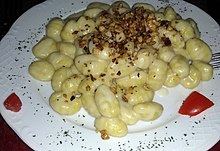
Pecorino Romano is a hard, salty Italian cheese, often used for grating, made with sheep's milk. The name "pecorino" simply means "ovine" or "of sheep" in Italian; the name of the cheese, although protected, is a simple description rather than a brand: "[formaggio] pecorino romano" is simply "sheep's [cheese] of Rome".

Halloumi or haloumi is a traditional Cypriot cheese made from a mixture of goat's and sheep's milk, and sometimes also cow's milk. Its texture is described as squeaky. It has a high melting point and so can easily be fried or grilled, a property that makes it a popular meat substitute. Rennet is used to curdle the milk in halloumi production, although no acid-producing bacteria are used in its preparation.

Parmesan is an Italian hard, granular cheese produced from cows' milk and aged at least 12 months.

Gorgonzola is a veined PDO Italian blue cheese, made from unskimmed cow's milk. It can be buttery or firm, crumbly and quite salty, with a "bite" from its blue veining. Outside the EU and the countries recognizing the geographical origin protection, the name "Gorgonzola" can legally be used for similar cheeses, with only the full Italian name unambiguously referring to PDO Gorgonzola. It is a famously pungent cheese.

Goat cheese, goat's cheese, or chèvre, is cheese made from goat's milk. Goats were among the first animals to be domesticated for producing food. Goat cheese is made around the world with a variety of recipes, giving many different styles of cheese, from fresh and soft to aged and hard.

Ricotta is an Italian whey cheese made from sheep, cow, goat, or Italian water buffalo milk whey left over from the production of other cheeses. Like other whey cheeses, it is made by coagulating the proteins that remain after the casein has been used to make cheese, notably albumin and globulin.

Burrata is an Italian cow milk cheese made from mozzarella and cream. The outer casing is solid cheese, while the inside contains stracciatella and cream, giving it an unusual, soft texture. It is typical of Puglia.

Buffalo mozzarella is a mozzarella made from the milk of Italian Mediterranean buffalo. It is a dairy product traditionally manufactured in Campania, especially in the provinces of Caserta and Salerno.

Grana Padano is a cheese originating in the Po river Valley in northern Italy that is similar to Parmigiano Reggiano cheese. There are less strict regulations governing its production compared to Parmigiano Reggiano. This hard, crumbly-textured cheese is made with unpasteurized cows' milk that is semi-skimmed through a natural creaming process. To preserve the authenticity of the manufacturing processes and raw materials used to make this cheese, Grana Padano is registered as Geographical Indication in Italy since 1954 and as a European Union protected designation of origin (PDO) since 1996, and is protected in several other countries based on the Lisbon Agreement and bilateral agreements.

Salers is a French semi-hard cheese originating from Salers, in the volcanic region of the Cantal mountains of the Massif Central, Auvergne, central France. It is a pressed, uncooked cheese, sometimes made from Salers cow's milk, between 15 April and 15 November. It is circular in shape, formed in rounds weighing around 40 kilograms (88 lb). The cheese is aged in caves at temperatures ranging from 6–12 °C for a minimum of 3 months, and up to 45 months.

Stracchino, also known as crescenza, is a type of Italian cow's-milk cheese, typical of Lombardy, Piedmont, Veneto, and Liguria. It is eaten very young, has no rind and a very soft, creamy texture and normally a mild and delicate flavour. It is normally square in shape.

Cheese is a dairy product produced in wide ranges of flavors, textures, and forms by coagulation of the milk protein casein. It comprises proteins and fat from milk. During production, milk is usually acidified and either the enzymes of rennet or bacterial enzymes with similar activity are added to cause the casein to coagulate. The solid curds are then separated from the liquid whey and pressed into finished cheese. Some cheeses have aromatic molds on the rind, the outer layer, or throughout.

There are many different types of cheese. Cheeses can be grouped or classified according to criteria such as length of fermentation, texture, methods of production, fat content, animal milk, and country or region of origin. The method most commonly and traditionally used is based on moisture content, which is then further narrowed down by fat content and curing or ripening methods. The criteria may either be used singly or in combination, with no single method being universally used.
Graviera is a cheese from Greece produced in various parts of Greece, the main of which are: Crete, Lesbos, Naxos and Amfilochia. It resembles gruyère, a Swiss cheese from whose name "graviera" is derived.

Raschera is an Italian pressed fat or medium fat, semi-hard cheese made with raw or pasteurized cow milk, to which a small amount of sheep's and/or goat's milk may be added. It has an ivory white color inside with irregularly spaced small eyes, and a semi-hard rind which is red gray sometimes with yellow highlights. It has a savory and salty taste, similar to Muenster cheese, and can be moderately sharp if the cheese has been aged.

Swiss-type cheeses, also known as Alpine cheeses, are a group of hard or semi-hard cheeses with a distinct character, whose origins lie in the Alps of Europe, although they are now eaten and imitated in most cheesemaking parts of the world. Their distinct character arose from the requirements of cheese made in the summer on high Alpine grasslands, and then transported with the cows down to the valleys in the winter, in the historic culture of Alpine transhumance. Traditionally the cheeses were made in large rounds or "wheels" with a hard rind, and were robust enough for both keeping and transporting.
















